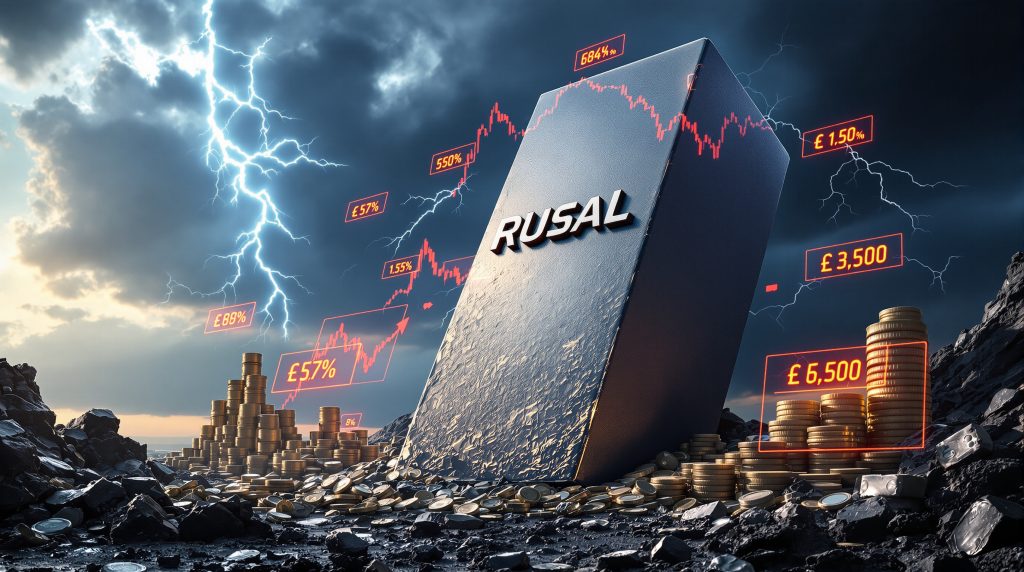Rusal's Financial Downturn: Understanding the Aluminum Giant's First-Half Loss
The global aluminum industry faces significant headwinds as Rusal, one of the world's largest aluminum producers, reports a substantial financial reversal. The company's transition from profit to loss highlights the complex challenges facing metal producers in today's volatile economic landscape.
What Caused Rusal's Swing to a First-Half Loss in 2025?
The aluminum giant's financial performance has deteriorated dramatically, with the company reporting a net loss of $87 million for the first half of 2025. This stark reversal contrasts sharply with the $565 million profit recorded during the same period in 2024, representing a concerning 115% negative swing in profitability.
Despite this bottom-line challenge, Rusal's revenue actually increased by 32% to $7.52 billion. However, this revenue growth was overwhelmed by a disproportionate 40% surge in cost of sales, which reached $6.11 billion during the period.
Key Financial Performance Indicators
The financial deterioration can be attributed to several factors:
- Operational costs: Cost of sales surged approximately 40% to $6.11 billion
- Finance expenses: Increased by $408 million year-over-year
- Currency exposure: Foreign exchange losses contributed $181 million to overall losses
- Revenue growth: Despite challenges, revenue increased 32% to $7.52 billion
These figures tell a story of a company caught between growing sales and even faster-growing costs, creating an unsustainable financial trajectory that demands strategic intervention.
Primary Factors Behind Rising Expenses
The dramatic increase in expenses stems from multiple pressure points throughout Rusal's operations:
- Volume-driven cost increases: Higher production volumes of primary aluminum have driven up overall costs
- Raw material inflation: Elevated prices for alumina and other critical inputs have squeezed margins
- Energy cost spikes: Aluminum smelting requires enormous electricity input, making the company vulnerable to rising energy prices
- Logistics challenges: Transportation expenses have climbed significantly, affecting both inbound raw materials and outbound finished products
- Debt service burden: Interest payments on bank loans, corporate bonds, and other financial instruments have risen substantially
The combination of these factors has created a perfect storm for Rusal's bottom line, requiring a comprehensive response to return to profitability.
How Has the Ukraine Conflict Affected Rusal's Business Operations?
The ongoing conflict in Ukraine has cast a long shadow over Rusal's operations for the past three years, creating both direct and indirect challenges for the aluminum producer.
Western Sanctions Impact
While Rusal itself has not been directly sanctioned by Western governments, the company has nonetheless faced significant business disruptions:
- Customer hesitation: Many Western buyers have become increasingly reluctant to enter new contracts for Russian metal
- Market access limitations: Traditional export markets have become more difficult to serve
- Banking restrictions: International financial transactions have grown more complex and costly
- Supply chain disruptions: Logistics networks have been reconfigured, often at greater expense
- Reputational concerns: Association with Russian industry has created image challenges in certain markets
The result has been a three-year period of sustained pressure on Rusal's business operations since 2022, forcing significant adaptations to its global strategy.
Market Position Challenges
As the largest aluminum producer outside China, Rusal has traditionally enjoyed significant global influence. However, this position is increasingly under pressure:
- Shifting market share: Regional competitors have gained ground in markets where Rusal faces access challenges
- Strategic repositioning: The company has been forced to develop alternative customer relationships in markets less affected by geopolitical tensions
- Product mix adjustments: Greater focus on markets and products less impacted by sanctions considerations
- Value chain integration: Vertical integration strategies to maintain control over inputs and outputs despite market disruptions
These adaptations reflect Rusal's efforts to maintain its global relevance despite unprecedented geopolitical headwinds.
What's Behind Rusal's Revenue Growth Despite Financial Losses?
The 32% increase in revenue to $7.52 billion presents an interesting counterpoint to Rusal's overall financial losses, highlighting areas of operational strength despite broader challenges.
Sales Performance Analysis
Several factors have contributed to Rusal's revenue growth:
- Volume increases: Higher sales volumes of primary aluminum have driven top-line growth
- Product mix optimization: Increased focus on higher-margin alloys and value-added products
- Strategic pricing: Adjustments to price structures in response to market conditions
- Market diversification: Expanding presence in regions less affected by geopolitical tensions
- Customer relationship management: Strengthening ties with key accounts to maintain volumes
These revenue growth drivers provide a foundation for potential recovery if cost pressures can be effectively managed.
Production Volume Trends
Behind the revenue growth lies significant operational activity:
| Production Metric | Performance | Impact |
|---|---|---|
| Manufacturing capacity utilization | Increased to near maximum levels | Higher fixed cost absorption |
| Output efficiency | Improvements at key facilities | Better production economics |
| Regional production distribution | Shifts toward lower-cost locations | Partial offset of cost inflation |
| Product mix | Higher proportion of specialized alloys | Improved margins on select products |
This operational strength demonstrates Rusal's continuing industrial capabilities despite financial pressures, providing a platform for potential future recovery.
How Are Raw Material Costs Affecting Rusal's Profitability?
The aluminum production process is notoriously input-intensive, making producers particularly vulnerable to raw material cost inflation.
Aluminum Production Cost Factors
Rusal's profitability has been squeezed by increases across virtually all input categories:
- Alumina prices: This critical input for aluminum production has seen significant price volatility
- Energy costs: Electricity represents approximately 30-40% of aluminum production costs, making energy price spikes particularly damaging
- Carbon materials: Petroleum coke and pitch used in anodes have experienced price increases
- Labor expenses: Workforce costs have risen across production facilities
- Maintenance and consumables: Routine operational expenses have increased with general inflation
These combined pressures have outpaced Rusal's ability to offset them through operational efficiencies or price increases, directly impacting profitability.
Supply Chain Challenges
Beyond simple price inflation, Rusal has faced structural supply chain challenges:
"The global aluminum supply chain has experienced unprecedented disruption over the past three years, requiring fundamental reconfiguration of sourcing strategies, logistics networks, and inventory management approaches." – Industry analyst specializing in metals markets
Key supply chain challenges include:
- Raw material sourcing difficulties: Traditional supplier relationships have been complicated by geopolitical factors
- Logistics disruptions: Transportation routes and modes have required adjustment, often at higher cost
- Inventory management complexity: Maintaining appropriate buffer stocks has become more difficult and expensive
- Supplier diversification requirements: Reducing dependency on any single source has added complexity
- Contract renegotiation necessities: Changing terms with suppliers to reflect new realities has proven challenging
These challenges have required significant management attention and resources, adding to the overall strain on profitability.
What Financial Challenges Is Rusal Facing Beyond Operational Costs?
While production and raw material costs represent significant challenges, Rusal also faces substantial financial structural issues that impact profitability.
Debt and Interest Burden
The $408 million increase in finance expenses represents a major drag on profitability:
- Interest rate pressures: Higher global interest rates have increased the cost of existing variable-rate debt
- Refinancing challenges: Securing new financing has become more difficult and expensive
- Bond market limitations: Corporate bond performance has suffered, affecting investor sentiment
- Credit rating implications: Continued losses threaten potential downgrades, which would further increase borrowing costs
- Debt restructuring constraints: Options for restructuring existing obligations may be limited by market conditions
This financial burden creates a challenging cycle where losses increase borrowing costs, which in turn make returning to profitability more difficult.
Currency Exposure Issues
The $181 million in foreign exchange losses highlights Rusal's vulnerability to currency movements:
- Ruble volatility: Fluctuations in the Russian currency directly impact financial results
- USD-denominated costs: Many raw materials are priced in dollars, creating currency mismatches
- Hedging limitations: Traditional currency hedging tools have become more expensive and less available
- Regional currency exposure: Operations across multiple countries create complex currency management challenges
- Treasury management complexity: Optimizing cash positions across currencies has become increasingly difficult
These currency challenges add another layer of financial complexity to Rusal's already challenging operational environment.
How Is Rusal Positioned in the Global Aluminum Market?
Despite current financial challenges, Rusal's position in the global aluminum industry remains significant, though increasingly under pressure.
Competitive Landscape Analysis
The company faces a shifting competitive environment:
- Chinese competition: Chinese producers continue to expand capacity and global reach
- Middle Eastern producers: Energy-advantaged producers in the Gulf region have gained market share
- Western producers: Companies less affected by geopolitical factors have strengthened positions in certain markets
- Recycled aluminum growth: Secondary aluminum producers have gained prominence as sustainability concerns increase
- Product differentiation: Competition in premium segments has intensified as producers seek higher margins
Rusal's traditional strengths in large-scale, integrated production must now adapt to this evolving competitive landscape.
Industry Outlook Factors
Several key factors will shape the aluminum industry's future trajectory:
| Factor | Outlook | Potential Impact on Rusal |
|---|---|---|
| Global aluminum demand | Projected growth of 3-4% annually through 2026 | Supportive of volume recovery |
| Price forecasts | Moderate strengthening expected in 2026 | Potential margin improvement |
| Supply-demand balance | Gradual tightening anticipated | More favorable pricing environment |
| Energy costs | Volatility expected to continue | Ongoing cost management challenge |
| Geopolitical factors | Continued uncertainty | Market access limitations likely to persist |
This mixed outlook suggests both opportunities and continuing challenges for Rusal as it navigates its current financial difficulties.
What Strategic Options Does Rusal Have to Return to Profitability?
Facing substantial financial challenges, Rusal must pursue a comprehensive strategy to return to profitability.
Cost Reduction Initiatives
Several potential approaches could help address the cost structure challenges:
- Operational efficiency improvements: Implementing advanced process controls and automation to reduce input consumption
- Energy consumption optimization: Investing in energy-efficient technologies and potentially developing self-generation capabilities
- Workforce productivity enhancement: Training programs and operational excellence initiatives to improve labor efficiency
- Procurement strategy adjustments: Renegotiating supplier contracts and exploring alternative sourcing options
- Technology investments: Deploying digital solutions to improve yield, reduce waste, and optimize production planning
A comprehensive approach across these areas could significantly improve Rusal's cost position and competitiveness.
Market Diversification Opportunities
Beyond cost control, Rusal can pursue several market-focused strategies:
- Geographic expansion: Developing stronger positions in markets less affected by current geopolitical tensions
- Product portfolio enhancement: Increasing focus on specialty alloys and other high-value products
- Value-added services: Expanding technical support, customization options, and other service offerings
- Strategic partnerships: Forming alliances with downstream manufacturers to secure stable demand
- Vertical integration: Securing control over critical inputs and potentially expanding into downstream activities
These market-oriented approaches could help stabilize revenue streams and potentially improve margins through a focus on higher-value opportunities.
FAQ: Understanding Rusal's Financial Performance
What is Rusal's current market position in the global aluminum industry?
Rusal maintains its position as one of the world's largest aluminum producers outside China, despite facing significant challenges from Western sanctions fallout and rising operational costs. The company continues to play a major role in global aluminum supply chains, particularly in markets where Russian metals face fewer restrictions. However, its market share has faced pressure in Western markets where customers have grown increasingly cautious about sourcing Russian metal.
How significant is the $87 million loss in context of Rusal's overall operations?
The $87 million loss represents a substantial financial reversal compared to the $565 million profit recorded in the same period last year. This 115% negative swing in profitability highlights serious challenges in cost management and international market access. However, when viewed in the context of Rusal's $7.52 billion revenue, the loss represents approximately 1.2% of revenue, suggesting that relatively modest improvements in cost structure or pricing could potentially return the company to profitability.
What specific cost factors are most significantly impacting Rusal's profitability?
The most impactful cost factors include:
- Rising prices for alumina (a key raw material in aluminum production)
- Significantly higher energy costs for power-intensive smelting operations
- Increased transportation expenses across restructured global supply chains
- Substantially higher interest expenses on the company's debt obligations
- Foreign exchange losses related to currency volatility
These factors have collectively overwhelmed revenue growth to push the company into a loss position.
Are there any positive indicators in Rusal's financial performance?
Despite the overall loss, several positive indicators suggest potential for recovery:
- 32% revenue increase to $7.52 billion demonstrates continued strong demand
- Successful efforts to increase sales volumes of both primary aluminum and value-added alloys
- Maintained production capabilities despite challenging circumstances
- Continued market presence in key regions
- Ongoing operational capabilities that could benefit from any improvement in market conditions
These strengths provide a foundation for potential recovery if the company can effectively address its cost challenges and financial structure issues.
Outlook: Navigating Challenges in the Aluminum Sector
Short-Term Recovery Prospects
Rusal's path to financial recovery in the near term will likely depend on several factors:
- Input cost stabilization: Any moderation in energy or raw material prices would provide immediate margin relief
- Operational efficiency gains: Continued focus on production optimization could partially offset cost pressures
- Working capital improvements: Better inventory management and receivables collection could ease financial strain
- Product mix enhancement: Shifting toward higher-margin products could improve overall profitability
- Currency stabilization: Reduced foreign exchange volatility would eliminate a significant drag on earnings
While a complete financial turnaround may take time, even incremental improvements in these areas could significantly improve Rusal's financial position.
Long-Term Strategic Considerations
Looking beyond immediate financial challenges, Rusal must position itself for the evolving aluminum market:
"The aluminum industry faces a fundamental transition toward sustainability, with low-carbon production becoming increasingly valued by customers and potentially commanding premium pricing in the future." – Metals industry consultant
Key long-term strategic priorities should include:
- Sustainable production investments: Reducing carbon intensity to meet evolving market expectations
- Technological innovation: Developing proprietary processes to achieve cost leadership
- Geographic diversification: Balancing global footprint to mitigate regional risks
- Value chain positioning: Identifying the optimal position within the aluminum value chain
- Financial structure optimization: Creating a more resilient balance sheet to weather future challenges
By addressing both immediate financial pressures and longer-term strategic positioning, Rusal can work toward reestablishing financial stability and sustainable growth in an increasingly challenging global aluminum market. The company must also navigate potential US tariffs and inflation impacts, as trade tensions could further complicate its recovery efforts.
Furthermore, oil price volatility represents another critical external factor that could affect Rusal's production costs and overall profitability. As energy represents a significant portion of aluminum production expenses, unstable oil markets create additional uncertainty for the company's financial outlook.
Industry analysts also note that broader mining industry trends will influence Rusal's strategic options moving forward. The aluminum sector faces similar sustainability challenges and technological disruption as other mining segments.
Investors should carefully monitor how tariffs impact markets generally, as aluminum prices could see significant fluctuations depending on trade policy developments. According to Reuters reports, Rusal swings to first-half loss as expenses surge, highlighting the volatile nature of the global metals market.
Additionally, potential US aluminum tariff exemptions could create selective advantages for certain market participants, potentially shifting competitive dynamics in ways that either benefit or further challenge Rusal's market position.
Want to Catch the Next Major Mining Discovery Before the Market Does?
Discovery Alert's proprietary Discovery IQ model provides real-time notifications when significant mineral discoveries are announced on the ASX, giving you an immediate market advantage. Explore historic returns from major discoveries and start your 30-day free trial today at Discovery Alert's discoveries page.




